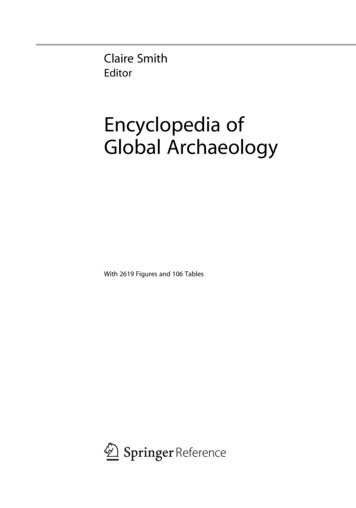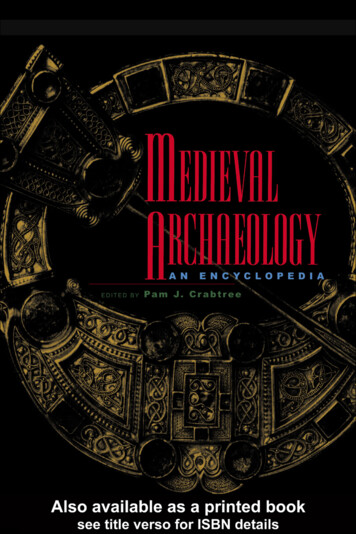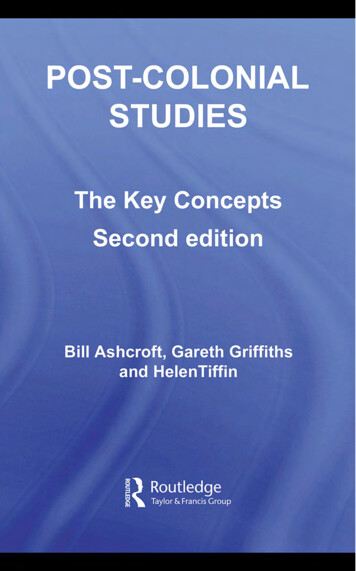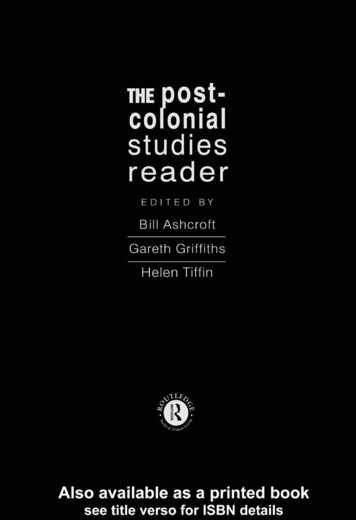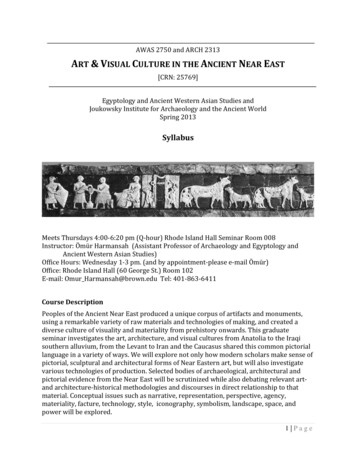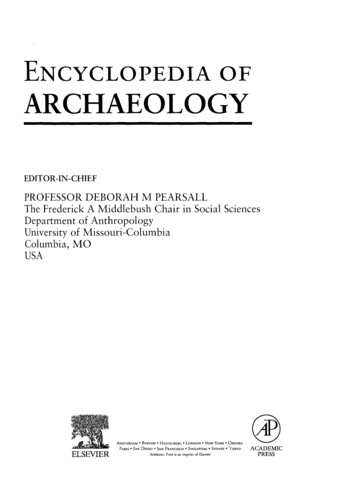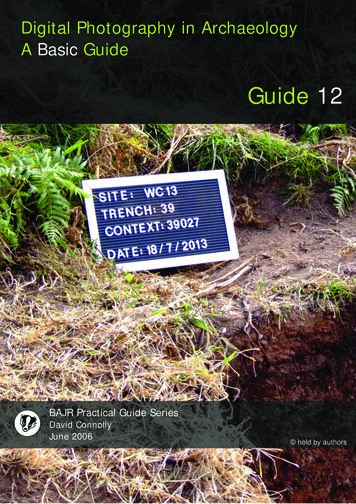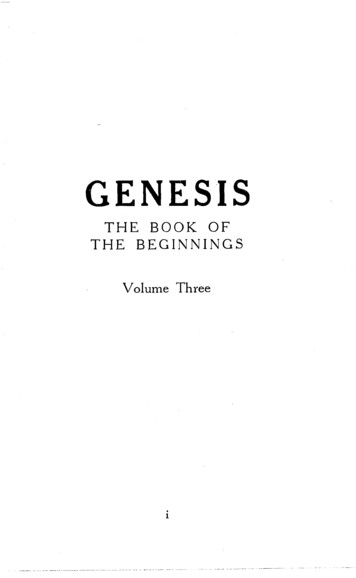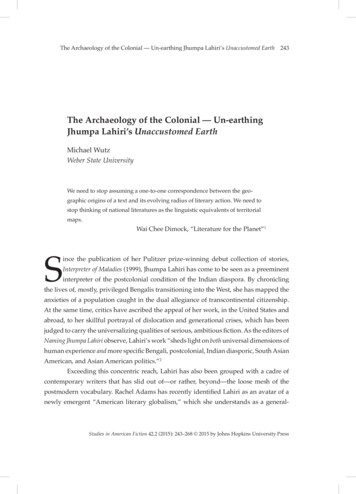
Transcription
The Archaeology of the Colonial — Un-earthing Jhumpa Lahiri’s Unaccustomed Earth243The Archaeology of the Colonial — Un-earthingJhumpa Lahiri’s Unaccustomed EarthMichael WutzWeber State UniversityWe need to stop assuming a one-to-one correspondence between the geographic origins of a text and its evolving radius of literary action. We need tostop thinking of national literatures as the linguistic equivalents of territorialmaps.Wai Chee Dimock, “Literature for the Planet”1Since the publication of her Pulitzer prize-winning debut collection of stories,Interpreter of Maladies (1999), Jhumpa Lahiri has come to be seen as a preeminentinterpreter of the postcolonial condition of the Indian diaspora. By chroniclingthe lives of, mostly, privileged Bengalis transitioning into the West, she has mapped theanxieties of a population caught in the dual allegiance of transcontinental citizenship.At the same time, critics have ascribed the appeal of her work, in the United States andabroad, to her skillful portrayal of dislocation and generational crises, which has beenjudged to carry the universalizing qualities of serious, ambitious fiction. As the editors ofNaming Jhumpa Lahiri observe, Lahiri’s work “sheds light on both universal dimensions ofhuman experience and more specific Bengali, postcolonial, Indian diasporic, South AsianAmerican, and Asian American politics.”2Exceeding this concentric reach, Lahiri has also been grouped with a cadre ofcontemporary writers that has slid out of—or rather, beyond—the loose mesh of thepostmodern vocabulary. Rachel Adams has recently identified Lahiri as an avatar of anewly emergent “American literary globalism,” which she understands as a general-Studies in American Fiction 42.2 (2015): 243–268 2015 by Johns Hopkins University Press
244Studies in American Fictionized feeling of social simultaneity across national borders, boundaries, and oceans, andwhich succeeds the more narrowly-Western aesthetic imperatives of the postmodern:“Relatively unburdened by the legacies of Euro-American modernism or the politics ofthe Cold War, their fiction reacts against the aesthetic sensibilities of high postmodern-ism while providing American literature with a new set of genealogical, geographic, andtemporal referents.”3This configuration of referents—from genealogy and geography to time, espe-cially the vast temporalities of geologic time—is indeed fully evident in Lahiri’s workand provides the framework for a sustained eco-critical reading of Lahiri’s collection ofstories and novellas, Unaccustomed Earth (2008). While Adams is primarily interestedin mapping a global sensibility in American fiction that is operative in the present, Iwant to extend those terms, both historically and geologically, into the past and futureby combining them with the thematic foci Lahiri’s work has, so far almost exclusively,been identified with: postcoloniality and immigration. Those twin themes provide thenarrative spark for the stories in Maladies, but don’t extend into historical or temporalreflection. The intergenerational vector of The Namesake (2003), Lahiri’s first novel, isdriven by time and change, but historical or geological ruptures are largely absent fromits texture. The Lowland (2013), Lahiri’s most recent novel, is rich with a colonial andecological sensibility that suggests centuries of human intervention and biological nichebuilding, but doesn’t explore them against planetary and geological time. Only withUnaccustomed Earth does Lahiri locate the story of migration and resettlement within theimmensities of a transhistorical scale;4 and only Unaccustomed Earth—as its earth-boundtitle already suggests—carries the imprint of a deeply felt environmental and ecologicalsensibility in its texture. The presence of natural history within a typically more narrowhuman history; an awareness of the agency of natural or nonhuman forces; a sense ofhuman accountability for its impact on the earth; and an understanding of the dynamicprocesses of the natural world—Lawrence Buell’s criteria for the identification of literarytexts as being properly imbued with environmental and ecological concerns are all fullyrealized in Lahiri’s collection.5It is against this geological, geographical, and ecological background that I wantto offer a reading of Unaccustomed Earth that revolves around the figurative axis of itstitle: the earth. I submit that Lahiri articulates a multi-leveled theory of postcolonialitythrough the trope of the earth itself, the terrific and terrifying terrain having offeredhumans habitation for millenia. As a layering of tensional plate tectonics, the imbricatedstrata of the earth’s crust become a figure for the dynamic forces of history pressing from
The Archaeology of the Colonial — Un-earthing Jhumpa Lahiri’s Unaccustomed Earth245their subterranean torque to the surface. Such a dynamic is often invisible but inscribedonly as an aftereffect in the human fossil record, the palpable repercussions derivingfrom cryptic human politics and policies (what Victorians called “the testimony of therocks”).6 Geological upheaval, in that sense, encodes the geopolitical upheaval that hasdivided global populations—at any point in their history—into dominators and domi-nated, colonizers and colonized; and it encodes the coming and going of civilizations,their waxing and waning, in concert with historical and terrestrial forces. Put differently,Lahiri seems to say, the unceasing energies of geo-historical change have made colonization, migration, and transplantation into the human condition per se—a kind of historicalnorm(alcy) that has pressured humanity into becoming a perennially transitional species.Exceeding such a geological understanding of the always already postcolonial,(with its suitably Foucauldian inflections of unearthing muted histories), the terraneantrope also grounds Lahiri’s understanding of writing in literary traditions that see humanlife, and indeed species behavior, in terms of migration and a re-grounding in the earthas a primal source of space, nutrition, and nourishment. If Unaccustomed Earth resonateswith structural allusions ranging from Homer and Hawthorne to Native American tales,it does so because Lahiri articulates her own location within a long and varied literarytradition that is mindful of the synergy between human settlements and their environ-ment. The resulting layering yields an archaeology of narrative that, while connectingto Homeric bedrock, condenses toward Lahiri’s historically recent contemporaries inthe American Renaissance, who ground her own interest in the myth of the Americanpastoral now enlarged to a global scale. Centered on the author’s own literary-culturalorigins, yet reaching back to the oral traditions in the West and beyond, UnaccustomedEarth embodies Wai Chee Dimock’s vision of American literature as part of a planetaryrhizome, to be seen “against the history and habitat of the human species, against the‘deep time’ of the planet Earth.”7In a final, outermost, yet most centrally ecological, layer of my argument, thecomplex trope of geological rupture in Unaccustomed Earth also intimates a radical changein agency with regard to the evolutionary ecology of humans and their global habitat.Nomadic tribes have for millennia flourished on the earth because of an essentially ecological synergy between soil and need. The earth has been able to get accustomed to thembecause their impact has been largely negligible. Yet beginning with the Industrial Revo-lution—when humans switched from wood and other renewable fuels to coal-poweredsteam technology—humanity for the first time in the history of the earth has evolvedinto a collective force with a veritable planetary impact so vast in scale that geologists
246Studies in American Fictionhave coined the term “Anthropocene” to mark this most recent moment in human-earthrelations.8 The contemporaneous geothermal upheavals and eruptions in UnaccustomedEarth might suggest the recuperative agency of a planet reacting to the destructive agencyof humanity—the damage done to its surface space and subterranean resources—andsuch a reading is certainly within the spirit of sustainability that undergirds UnaccustomedEarth. Lahiri, however, works on a much larger (appropriately, geological) scale thanpuny human concerns of species survival, ecological responsibility, or adaptability. Moreconcerned with cosmic rhythms and natural forces than human purpose or teleology,Lahiri suggests that the seismic energies in Unaccustomed Earth signify a planet with thecapacity for perpetual reconstitution, that a humanity unaccustomed (or unaccustomable)to symbiotic thinking may, indeed, be a transitional sojourner on the diasporic space thatis the earth, and that change is the one large bio-geological constant in the age-old gameof migration and transplantation.Thus, this essay seeks to locate Lahiri’s oft-cited interest in generational migrationand postcolonial thinking within a larger geological and ecocritical framework that has, sofar, escaped critical attention. It seeks to unearth a literary genealogy that grounds Unac-customed Earth in a, predominantly (but not only), American tradition with the pastoral;and it advances a reading of Unaccustomed Earth along the lines of a renewed interest inmaterialism in American culture, not only by acknowledging, as does Lahiri, the agencyof the earth as an active and reactive biological entity, but also by being cognizant of theway “seemingly insignificant daily activities work synergistically to produce effects thatdevastate the global environment.”9Geological Upheaval, Geopolitical UpheavalIt is in detecting the traces of that uninterrupted narrative, in restoring to thesurface of the text the repressed and buried reality of this fundamental history,that the doctrine of a political unconscious finds its function and necessity.Fredric Jameson, The Political Unconscious10Unaccustomed Earth introduces the subterranean energies of the earth, in both thepast and the present, as its very framing condition. The collection’s title story takes placein Washington State, home to the dormant volcanic range of the Cascades; Ruma has aspectacular view onto “the Olympic Mountains, whose snowy peaks seemed hewn fromthe same billowy white of the clouds drifting above them.”11 In the volume’s concludingstory, Kaushik retraces his travels through Central and South America, which are locatedon the same tectonic fault lines that connect the Northern and Southern hemispheres in
The Archaeology of the Colonial — Un-earthing Jhumpa Lahiri’s Unaccustomed Earth247deep, geological terms. His beginnings as a photojournalist explicitly link geology togeopolitics. In El Salvador, he first takes “pictures of the volcano that loomed west ofthe capital, buildings pocked by bullets and cracked in half by an earthquake earlier thatyear” (303). Shortly thereafter, while eating lunch with a Dutch photo journalist, “the table[begins] to shake, dark stew spilling from bowls. By then he had grown used to occasionaltremors, the earth’s violence yielding a moment’s pause” (304).12 In the instant following,he takes his first picture of political violence—of a young man bleeding to death—thuscapturing the civil unrest and revolutionary ferment of a country that is intimated in thesubterranean trembles and the overflowing stew-qua-magna.What is more, both framing narratives connect to Italy and the Mediterraneangenerally as one of the cradles of Western civilization with a long history of geologicalactivity, conquest, and colonialism. The Olympic Mountains derive their name from MountOlympus in Greece, and Ruma’s father has just recently returned from Italy, equippednot only with the clichéd knick-knacks of a global consumer economy, but also sport-ing a baseball hat with the imprint of POMPEII (11), thus providing a first glimpse intoItaly’s violent volcanic and historical past. “Going Ashore” extends this history into thevanished culture of the Etruscans, a mysterious civilization who, as Hema puts it, “hadpossibly wandered from Asia minor to central Italy and flourished for four centuries, whohad ruled Rome for one hundred years before turning obsolete” (300).13 During Hemaand Kaushik’s visit to Volterra, a town founded by the Etruscans, they note its precari-ous position “perched on a cliff high above the open countryside,” and when they peer“over the walls at the Balze, a precipice beneath which the earth had fallen away,” theyobserve the remnants of a church below and an actively morphing landscape “alwaysthreatening to take more” (318–19).Significantly, Volterra (following a violent takeover by the succeeding culture)was a Roman stronghold through the Second Punic War (205 BC) and actively involvedin the Roman civil wars (81–80 BC), before taking the Latin name of Volaterrae, whichroughly translates, as the narrative itself suggests, as “an island surrounded by land,”and which is indeed within view of the Ligurian Sea (318). Thus, as with the current geothermal rumbles in El Salvador, but now removed in geographical space and historicaltime, political and geological instability coalesce into a statement about the ficklenessof human civilizations against the backdrop of geological forces. Whether in the case ofItaly’s Volterra or El Salvador’s terra nostra (to speak with Carlos Fuentes), terra infirma—the unruly earth following its own internal laws—may, indeed, be the critical historicaldeterminant and the name of the global human game of migration and mortality.14
248Studies in American FictionThe punctual references to current political events embedded in the surfacenarrative of Unaccustomed Earth, in that sense, are legible as the aftershocks of the text’sdeeper narrative, which recounts the long-term effects of global imperial politics. Morethan simple orienting markers to endow the collection with a contemporary flush, theycondense into a narrative of colonial violence that has repercussions for and into thehistorical present.15 When Amit returns to New Delhi “the year of Indira Gandhi’s assas-sination,” in 1984, “the riots that subsequently raged there, the curfews and the constantvigilance with which his parents had to live,” effectively put him under house arrest,and he experiences a fractured country in the condition of a police state, whose historicalorigins hearken back to British colonial rule (96). Similarly, when his boarding schoolhosts its annual Thanksgiving dinner, gathered around the table are young expats from“Santiago, Tehran, and other troubled parts of the world,” who were unable to return totheir home countries because of internal strife and political instability, thus gesturing toChile and Iran’s histories of imperial domination and fights for independence (98). Thepolitical aftershocks of the Middle East and South America resurface in UnaccustomedEarth once more when Hema and Kaushik’s parents speak “about Reagan winning theelection, all the ways that Carter had failed,” and when Hema, shortly thereafter, explainsto a newly-returned Kaushik the significance of “yellow ribbons” in the context of theIran-Contra crisis (233, 235). Pranab and Usha’s father discuss “Kissinger and Water-gate” to intimate the Indo-Chinese theater and the covert and overt U.S. interventions inSouth America (67), and, in the collection’s concluding story, Kaushik’s professional lifereads like a summary of migration and political violence the world over, as if to suggestthat—coincident with the terminal layer of the narrative—the archaeology of the effectsof imperial politics is up to date.Starting out as a photographer in El Salvador and then Mexico and Argentina,Kaushik amasses pictorial evidence so ghastly that he “could no longer remember all thecorpses he had photographed” (305). He works in Israel, part of the war-torn Mediter-ranean cradle of civilization, covering the “bombing of a hotel banquet hall,” and, oncestationed in Rome, photographs “Senegalese immigrants in Italy” and “the nineteencaskets containing the soldiers in Iraq being carried past the Colosseum”—the ancientarena of deadly combat accentuating contemporary warfare (302).16 Eventually posted inthe Middle East, he covers the “Second Intifada” (307) and “Arafat’s funeral” in Ramallah,where thousands of mourners had been “scaling walls and tearing down barbed wirefor a glimpse of the coffin.” A “detailed map of the West Bank” and “an internationalnews channel,” turned to silent, help him trace moment-by-moment developments in the
The Archaeology of the Colonial — Un-earthing Jhumpa Lahiri’s Unaccustomed Earth249region (315–316), and even his scheduled relocation to Hong Kong figures as a symbolicsite of cultural and economic diffusion, with a long and recent history of conquest andterritorial transfer.Thus, in their entirety, these scattered escarpments of violence in countries witha recent colonial past suggest a reading of the shards of an historical archaeology aggregated into the deep structure of Unaccustomed Earth. Precisely because these scarringsare below the surface of the narrative, they point to the subterranean energies that havemoved the collection’s players to their destinations, in both local and economic terms.The global mobility of the diaspora—including the paradigmatic little Neel, who descends from Indian-born grandparents, a mother born in Britain but reared in the UnitedStates before returning to the seat of the former Empire, there to meet her Indian-bornEnglish husband and give birth to their postcolonial son—are effects of imperial powerthat, to this day, trigger and orchestrate migrant fluidities, boundary dissolutions, capi-tal flows, and, of course, numerous civil wars and the emergence of new countries andethnic identities. Unaccustomed Earth illuminates this power through such moments of(e)rupture, when brief historical probes break through the narrative surface to lay barethe larger, and often buried, forces of historical agency. Mediated through the trope ofdeep geological activity and layering, with its irruptive vectors upward and outwardand its often complex agency, Unaccustomed Earth exemplifies a form of what FredricJameson has called “the political unconscious,” which denotes the fact that texts containirrepressible political energies pushing from the subtextual deep. For Jameson, that valuelies primarily in “detecting the traces of that uninterrupted narrative”—of class struggleand displacement—for historical modernity, and in “restoring to the surface of the textthe repressed and buried reality of this fundamental history.”17 Lahiri, working with alarger aperture, extends that history to the immemorial beginnings of human civilizations: that is, to geologic time.Narrative Archaeologies and the Contingency of the PostcolonialGiven the history of the United States, all American fiction could be classifiedas immigrant fiction. . . . From the beginnings of literature, poets and writershave based their narratives on crossing borders, on wandering, on exile, onencounters beyond the familiar.Jhumpa Lahiri, “By the Book”18Building on the geopolitical tectonics rumbling underneath Unaccustomed Earth,and indeed informing its migratory dynamic, Lahiri also striates her narrative with lit-
250Studies in American Fictionerary traditions that resonate with (pre)historical migration and concerns for the earth.More than a matter of “Tradition and the Individual Talent,” in which contemporaryauthorship is imbued with “the whole of the literature of Europe from Homer” and whichassumes the historical timelessness of a “simultaneous order,” Lahiri allows significantprior work to resonate in her own, without, as Eliot would ask, “the continual surrenderof [her]self.”19 On the contrary, Lahiri writes herself into various traditions that reflecther thematic affinities with migration and the earth, and in so doing breaks new groundon the transnational literary terrain.Lahiri’s nod to Homer, for example, figures as a feminist rewriting of one of theWestern world’s founding narratives of travel and migration, and gestures to the OlympicMountains and vanished cultures of the collection’s opening. But rather than strainingfor a sustained parallelism between The Odyssey and, say, Ulysses, as does Joyce in hismodernist epic, Lahiri embeds textual shards into her own narrative that are more allusivethan strictly allegorical, suggesting the limits of such male-driven master narratives forher own project. Much like the itinerant Odysseus, Rahul in “Only Goodness” is in searchof unaccustomed earth, which he first finds in the ports of call of the Greek’s peregrina-tions: he enrolls in Ithaca (Cornell), wooded and mountainous like Odysseus’ home,from where he is expelled, and eventually settles in Syracuse (whose Greek namesakeis within view of Mount Etna), where he lives with Elena, the woman bearing a suitably Greek name. Sudha looks up the town in “an atlas”—another, literal, echo of Greekpath-finding—and clinches the circular travels of both voyages: “The town was north ofIthaca. . . . She never thought he’d want to return anywhere near the place where he hadso spectacularly failed” (160). What is more, during his meanderings, Rahul also sendsa letter from “Columbus, Ohio,” thus figuratively extending his role as an arch-explorerto the putative discoverer of America, who was as much in search of India as Rahul istrying to get away from it (158).More importantly, it is Sudha (whose Hindi name signifies “living water”) whois cast in the role of a female Odysseus trying to navigate her way through a patriarchalworld as yet unaccustomed to womanly strength and independence. When her brotherannounces his rash engagement, Sudha is temporarily thrown off course, aware that hislife of preferential parental treatment has led to irresponsibility and sibling rivalry: “Theroom seemed to tilt; she pressed down on the table cloth as if a forceful wind were aboutto come and blow everything away” (154). Similarly, when she learns of her parents’narrative of almost-expulsion from a racist England as yet unaccustomed to its formersubjects, she sees the story “like an episode out of a Greek myth or the Bible, rich with
The Archaeology of the Colonial — Un-earthing Jhumpa Lahiri’s Unaccustomed Earth251blessing and portent, marking her family as survivors in strange intolerant seas” (135).20Like her mythological template, Sudha wears a “protective coating”—a diamond ringconcealed on a chain beneath her sweater—to give her immunity (149), and when shereturns to the country of her birth, she feels “an instinctive connection” and “a sense ofbelonging” (144). The immigration officer at Heathrow—much like Eumaeus in Odysseus’Ithaca—is the first who “welcomed her home” (144). Her nostos, already legitimized byher new British passport and much in contrast to the male narrative of failure, is broughtto a close in educational and social terms through a Ph.D. and a family.As variants of such allusive textures, fairy tales form part of the narrative bed-rock of Unaccustomed Earth as well, and provide similar textual density along the linesof growth and cultivation. Fed on a steady diet of TV, little Akash may, in the title story,already have seen Disney’s Pinocchio by the time his grandfather brings the puppet fromItaly. The gift embodies the intergenerational relationship between the paternal Dadu andthe filial grandson, and Akash’s growing experiences under the tutelage of his Geppetto.Not only does Akash perform his first baby steps in Hindi during the grandfather’s stay,thus fostering his re-grounding in the language and culture from which he is removedby two generations. Much like his wooden model, who plants gold coins in the “Field ofMiracles,” in the naïve belief that they will multiply, Akash sows his own field of miraclesunder the direction of this grandfather, thus linking the tale explicitly to the motifs ofgrowth and sustenance at the heart of Unaccustomed Earth (44).For that very reason, the intertextual tectonic Lahiri acknowledges uppermostis announced in the collection’s title and elaborated in its epigraph. It is the deepest andmost immediately grounded in Unaccustomed Earth, and it is, significantly, the most American, resonating as it does with transplantation and the ethos of a virgin continent. If theOdyssey and the Mediterranean provide the locale for cultures come and gone (even asimmigrants from Senegal settle in present-day Italy), the land known as America providesnew ground for growing cultures (even as it has already unsettled native populations). Itderives from the beginning of Nathaniel Hawthorne’s “The Custom-House,” the prefaceto The Scarlet Letter, when the narrator distances himself from his ancestors, whose infamous involvement in the Salem Witchcraft Trials makes any close association uneasy:“Human nature will not flourish, any more than a potato, if it be planted and re-planted,for too long a series of generations, in the same worn-out soil. My children have hadother birthplaces, and, so far as their fortunes may be within my control, shall strike theirroots into unaccustomed earth.”21 What is more, the narrator’s figural use of a potato notonly connects to a crop that has, for millennia, been domesticated by numerous cultures,but also explicitly associates agricultural with human transplantation and colonization.
252Studies in American FictionThe motifs of gardening and (trans)plantation form of course the narrative bed-rock of Unaccustomed Earth and link Lahiri explicitly with the pastoral ideal in Americanliterature, as it was first and most prominently articulated by Henry Nash Smith andLeo Marx. The notion of an agricultural society became a “poetic idea” that defined“the promise of American life. The master symbol of the garden embraced a cluster ofmetaphors expressing fecundity, growth, increase, and blissful labor in the earth.”22 LikeHawthorne, Lahiri significantly adds the severance of old and the knitting of new bonds,across generations and continents, to this master trope, and like Hawthorne, Lahiri suggests in numerous scenarios that a form of crop rotation is the template for agriculturalvitality, growth, and rejuvenation, just as it is for human colonizing and migration.23Lahiri has been explicit about this recognition of kinship with a writer who, fordecades, served as an anti-model of what she aspired to be. Upon re-reading Hawthornewhile working on the collection, she wasboth startled and unspeakably reassured. I felt that a writer who represents everythingthat I seemed not to be while growing up—an American, a New Englander, whose work isset in the very terrain in which I was raised and from which I felt always estranged—hadarticulated, almost two centuries ago, the journey and experience of my family, and hadalso expressed my project as a writer.24Sensing a deep rapport “across space and time” with her canonical predecessor, Lahiriidentifies that connection as appropriately geological: “It was the crossing of a fault line.”25Lahiri’s corresponding gestures toward Emerson and Thoreau reaffirm her intel-lectual heritage and further combine notions of migration with those of cultivation. TheIndian-born Pranab does an improvisational doggie paddle in Walden Pond and performsthe quintessential American act of sink-or-swim, as have generations of newcomersbefore him trying to make it on the slippery slopes of an unaccustomed earth (66). Paul,the only European American narrator in the collection, spots two people “swimming inWalden Pond, their heads above the surface of the water,” even as he himself has a hardtime staying afloat (200). And the Canadian-born Deirdre tells Paul that her Egyptianlover took her to Walden Pond “[f]or their first date” before sharing a meal (197). All payhomage to the baptismal font of American self-reliance, the trough of absolution, courage,and tenacity that has come to symbolize resolve and risk, watering and growth. And inwhat amounts to a refresher of his own reliance, Paul makes a pilgrimage to “Concord,to visit Emerson’s house,” to supplement his readings for his Ph.D. exam in English, thefield trip ostensibly promising experience on the ground no amount of reading can offer
The Archaeology of the Colonial — Un-earthing Jhumpa Lahiri’s Unaccustomed Earth253(200). With Hawthorne as a key archaeological link—whose model of crop rotation sug-gests a “proto-ecological” sensibility (the phrase is Karl Kroeber’s)—Lahiri locates herown genealogy in the tradition of nineteenth-century American writing about the land,which functions, as Lawrence Buell succinctly put it, “as a bridge, crude but serviceable,from anthropocentric to more specifically ecocentric concerns” (52).26What is important here is that Lahiri combines the predominant theme of humanwith the notion of literary migration, grounded as it is in ancient Mediterranean cultureor, more prominently, the writings of the American Renaissance. In so doing, she offersan expanded understanding of what it means to inhabit a colonized space. If the term“postcolonial” in contemporary discourse generally marks the political landscapesand transnational migration flows following World War II, Lahiri draws attention tothe historical permanence—or, better, historical contingency—of postcoloniality per seby foregrounding various proto-postcolonial moments of American history. Beginningwith Hawthorne’s mid-nineteenth-century America, when the former British colony wasbeginning to emerge as a major immigrant country, Unaccustomed Earth gestures towardthe influx of today’s global diaspora into the United States, while locating the country’sprecolonial past in the settlers’ first mythical encounter with the Native American other:Thanksgiving. (That is also the moment, as the narrator of “The Custom-House” putsit, “when India was a new region
246 Studies in American Fiction The Archaeology of the Colonial — Un-earthing Jhumpa Lahiri’s Unaccustomed Earth 247 have coined the term “Anthropocene” to mark this most recent moment in human-earth relations.8 The contemporaneous geothermal upheavals and eruptions in Unaccustomed Earth mig
